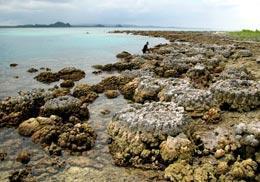Geoscientists have used corals before to look at earthquake history, by studying the terraced growth patterns that result. A major quake can push up an entire region, thrusting parts of a reef above the low-tide level, killing the exposed coral polyps. The rest of the coral continues to grow, producing a 'hat-brim' pattern that can indicate elevation changes as small as a few centimetres. This phenomenon has allowed scientists to date many earthquakes, including major ones in 1797 and 1833 off Sumatra, Indonesia. But the pattern erodes over time, so it can only be used to identify quakes that occurred within the past few hundred years.

|
| ©Soc./EPA/Corbis |
| Wildlife Conservation |
Now, Michael Gagan, a palaeoclimatologist at the Australian National University in Canberra, and his colleagues have come up with a method that relies on a more durable and prevalent record: earthquake-induced shifts in the way that corals store carbon. It could allow researchers to determine the long-term recurrence rate - going back thousands of years - of major quakes in places such as Sumatra, where the Australian tectonic plate is butting up to the plate on which Sumatra rests.
"We can go back further in time and apply it to any reef in an earthquake-prone area," says Gagan, who presented the method on 15 July at the Goldschmidt geochemistry conference in Vancouver, Canada. "I'm being conservative in saying I'm sure we can go back 7,000 years."
The method relies on the ratio of carbon isotopes deposited in the coral by the photosynthetic algae that live symbiotically in it. Algae discriminately process carbon-12 from the water during photosynthesis, and when the light is stronger, for example in the summer, they process more of it. Gagan and his colleagues noticed a similar effect: when an earthquake pushes coral closer to the light, the algae process more carbon-12, leaving a higher proportion of carbon-13 in the surrounding water. The coral, which does not discriminate, therefore absorbs more carbon-13, which can be detected in the coral skeleton.
The sudden shift in isotope ratio - a "big" jump compared with the seasonal average, Gagan says - can be dated precisely. Uranium - thorium isotope dating can pinpoint events to within 1% of the age of the coral, and annual growth bands, like tree-rings, can also be counted. And unlike the existing method, which involves cutting through the coral with a chainsaw, the new method needs only small cores.
Fred Taylor, a geologist at the University of Texas in Austin, who pioneered the 'hat-brim' analysis, says the new method holds promise. "It's a big deal in our little world," says Taylor, who wants to apply Gagan's technique to an earthquake-prone area near the Solomon Islands.
Gagan says the method could also be used to determine whether the recurrence rate for large Sumatran earthquakes has changed over time. A change would indicate that the Australian plate slips erratically below its neighbour, an issue debated by geologists. The method could also be used to distinguish events just a few months or years apart - important if geologists are to learn whether these major quakes come in pairs. For example, geologists suspect that the 1797 earthquake triggered the one in 1833, just as the 2004 earthquake led to another whammy in 2005.
The fault movement needs to have been fairly big - around 30 centimetres - to be detectable and so the method would work best on the big earthquakes, Gagan says. The carbon-isotope signal from smaller quakes could be confused by other events that cause changes in the amount of light a coral receives.
Gagan thinks the method might even help predict quakes. He says that data collected before the 2004 earthquake suggest that there is a change in the subsidence rate of the 'upthrust' region over the five years preceding a quake. If this pattern is borne out in studies of historical quakes, then "maybe it will have some predictive use", he says.



Reader Comments
to our Newsletter